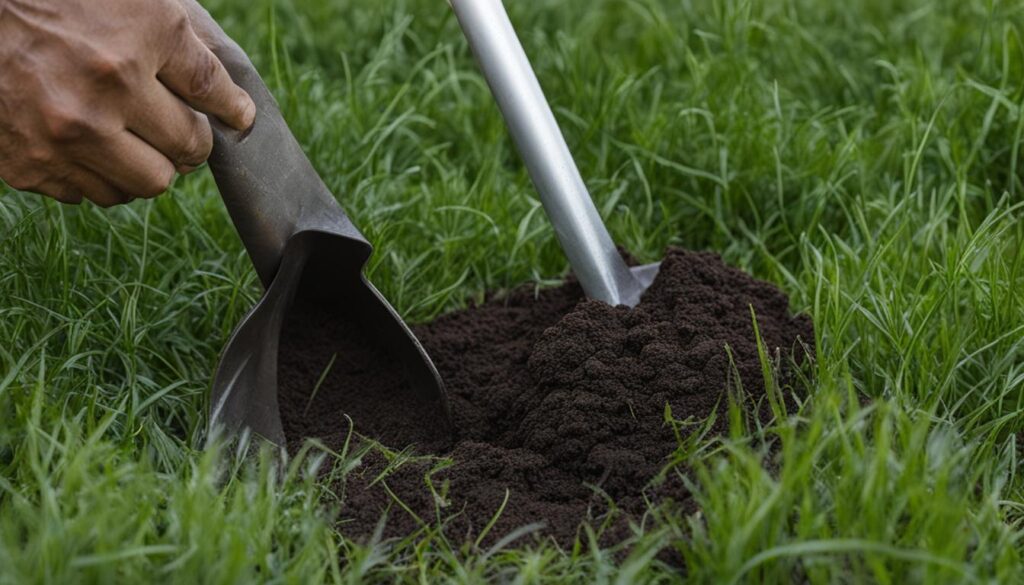Welcome to our comprehensive guide on how to grow grass from dirt and achieve a lush, vibrant lawn. Whether you’re starting from scratch or want to revive your existing lawn, we’ll provide you with the expert tips and techniques you need to succeed. Creating a beautiful lawn is within your reach, and we’re here to help every step of the way.
Are you ready to transform your patch of dirt into a green oasis? In this article, we’ll cover everything you need to know about selecting the right grass seed for your region, preparing the soil, sowing and tamping the seed, watering for successful germination, and implementing organic lawn care practices.
Don’t worry if you’re a beginner; our step-by-step instructions are easy to follow and suitable for any level of experience. Before you know it, you’ll be enjoying a lush, healthy lawn that will be the envy of your neighborhood.
So, whether you dream of hosting picnics on a soft carpet of grass or simply want to enhance the curb appeal of your home, let’s dive into the world of lawn care and discover how to grow grass from dirt. Get ready to experience the joy of watching your lawn transform and flourish into a beautiful outdoor space you can truly be proud of.
Choosing the Right Grass Seed for Your Region
Cool-season grasses and warm-season grasses are two broad categories of grass that thrive in different climate zones. Understanding the characteristics of each type will help you choose the right grass seed for your region. This will ensure that you have a lush and healthy lawn that can withstand the challenges specific to your area.
One type of grass that falls under the cool-season category is ryegrass. Ryegrass is known for its ability to tolerate cold winters and establish quickly. Another popular cool-season grass is Kentucky bluegrass, which is known for its lush, dense growth and tolerance for foot traffic. These cool-season grasses are well-suited for regions with warm summers and cold winters, which include the upper two-thirds of the United States.
On the other hand, warm-season grasses like Bermuda grass and St. Augustine grass thrive in hot southern climates. They are known for their ability to withstand high temperatures and their excellent drought tolerance. If you live in the central slice of the country, known as the Transition Zone, a mix of sturdy grass varieties like Kentucky bluegrass and tall fescue is recommended. These grasses can handle the climatic challenges of this region, which falls in between the cool-season and warm-season zones.
When choosing the right grass seed, it’s important to consider your lawn’s unique attributes. These attributes include the amount of shade your lawn receives, the level of foot traffic it experiences, the frequency of watering, and the amount of maintenance you are willing to put in. Some grasses are more shade-tolerant, while others are better suited for high-traffic areas. Some grasses require frequent watering, while others are more drought-tolerant. By taking these factors into account, you can narrow down your choices and select the grass seed that will thrive in your specific lawn conditions.
If you’re looking for a more low-maintenance lawn, there are also grass alternatives worth exploring. Thyme lawns and wildflower meadows can provide a natural and vibrant alternative to traditional grass lawns. They require less water, fertilizer, and mowing, making them a more environmentally friendly choice.
Remember, choosing the right grass seed is the foundation of a beautiful and resilient lawn. By selecting a grass variety that suits your region and matches your lawn’s attributes, you can enjoy a thriving and visually appealing outdoor space for years to come.
Preparing the Soil for Planting Grass Seed
Before you can begin planting grass seed, it is crucial to properly prepare the soil. By taking the time to prepare the soil, you can create the ideal conditions for your grass to thrive. Here are some steps to follow:
Step 1: Conduct a Soil Test
To ensure the success of your lawn, it is essential to understand the pH levels and nutrient content of your soil. Conducting a soil test will provide valuable information that will guide your soil preparation. You can easily obtain a soil test kit from your local garden center or contact a professional lab for more accurate results.
Step 2: Amend Acidic Soil
Based on the results of your soil test, you may discover that your soil is acidic. It is important to amend acidic soil to create a more favorable environment for grass seed germination and growth. One effective way to do this is by adding ground limestone to the soil. The limestone will help neutralize the pH levels and create a more balanced soil environment for your grass to grow.
Step 3: Incorporate Organic Matter
In addition to balancing the pH levels, adding organic matter to your soil can greatly improve its quality. If your soil is sandy or has a high clay content, incorporating organic matter such as compost or well-rotted manure can help improve its ability to retain moisture and oxygen. Organic matter also adds essential nutrients to the soil, creating a fertile environment for your grass seed to take root and thrive.
By following these steps and preparing the soil properly, you are setting the foundation for a successful grass growing journey. Taking the time to assess your soil’s characteristics and make necessary amendments will greatly increase the chances of achieving a lush and healthy lawn.
Sowing and Tamping the Grass Seed
Now that you have prepared the soil, it’s time to sow the grass seed and ensure its proper germination. To achieve even distribution, use a lawn spreader to scatter the seeds across the desired area. This will help you achieve a uniform coverage for a lush and healthy lawn.
After spreading the seeds, give them a light layer of soil coverage using a rake. This step is crucial as it protects the seeds from birds and helps retain moisture necessary for germination. Make sure to cover the seeds gently, as excessive soil depth can inhibit their growth.
To further enhance the seed’s chance of germination and prevent erosion, it is essential to tamp the seed into the soil. This can be done using a lawn roller filled with either water or sand. By gently rolling over the seeded area, you compact the soil, ensuring close contact between the seeds and the ground. This process also helps prevent seed displacement and encourages faster and more successful germination.
Watering the Lawn for Successful Germination
Proper watering is crucial for the successful germination of grass seeds. To ensure your newly seeded lawn thrives, it’s essential to establish a consistent watering routine.
Immediately after seeding, soak the soil 4 to 6 inches deep using a sprinkler or hand sprayer. This initial watering helps to activate the seeds and promote germination. Pay close attention to different areas of your lawn, adjusting your watering efforts accordingly to ensure even coverage.
Weather conditions influence the watering frequency during the germination period. In general, it is recommended to water your newly seeded lawn daily or twice daily to keep the soil evenly moist. Be mindful of the weather forecast and adjust your watering schedule as needed to prevent over or under-watering.
Pro Tip: To gauge the moisture level of the soil, gently press your finger into the ground. If it feels dry, it’s time to water.
Once the grass seed begins to sprout and reach a height of about a half-inch, you can transition to a less frequent watering schedule. At this stage, water at a rate of one inch per week to promote deep root growth and drought tolerance.
Deep watering encourages the roots to grow deeper into the soil, making your lawn more resilient during periods of drought. Remember to water in the early morning or late afternoon to minimize evaporation and maximize absorption.
Did you know? Deep watering encourages grass roots to grow deeper into the soil, making your lawn more resistant to drought conditions.
By following the proper watering practices, you can ensure successful seed germination and establish a healthy and vibrant lawn.
Organic Lawn Care Tips
If you prefer organic lawn care, there are a few tips to keep in mind.
- Avoid over-mowing your lawn and maintain a grass height of 3 inches to promote healthy root development.
- Use organic soil amendments like compost to enhance the soil’s nutrient content and water-holding capacity.
- Try natural weed control methods, such as corn gluten meal, to prevent weed growth without the use of synthetic chemicals.
- Hand pulling weeds is another effective and eco-friendly option.
Increasing organic matter in the soil through amendments improves its water-holding capacity, making it less susceptible to drought conditions. Additionally, organic matter encourages root growth, creating a healthy and resilient lawn. By following these organic lawn care tips, you can maintain a lush and vibrant lawn while minimizing environmental impact.
Can the same method be used to grow warm season grass as regular grass from dirt?
Yes, the same method can be used to grow lush warm season grass as regular grass from dirt. Water, sunlight, and proper soil preparation are essential for successful establishment. Depending on the specific warm season grass, additional considerations such as ideal growing temperatures and fertilization may apply.
Conclusion:
Growing grass from dirt is a straightforward process that can lead to a lush and healthy lawn. By following the right steps and implementing proper lawn care techniques, you can transform your bare soil into a beautiful oasis of green. Choose the right grass seed that suits your region’s climate and your lawn’s unique attributes, such as shade tolerance and foot traffic. Preparing the soil by conducting a soil test and amending it if necessary is crucial for successful grass growth. Sow and tamp the seed properly to ensure good seed-to-soil contact, and water the lawn consistently to promote germination and growth.
When it comes to lawn care, organic methods can be beneficial. Maintain a consistent grass height and use organic soil amendments to improve the soil’s water-holding capacity and root growth. Implement natural weed control methods to keep your lawn healthy and weed-free. Remember to tailor your lawn care routine to your specific region’s climate and the unique attributes of your lawn.
With dedication and proper maintenance, your grass will flourish, and you’ll be rewarded with a stunning, lush lawn that you can enjoy for years to come. So go ahead, apply these lawn care tips and watch your grass thrive!











